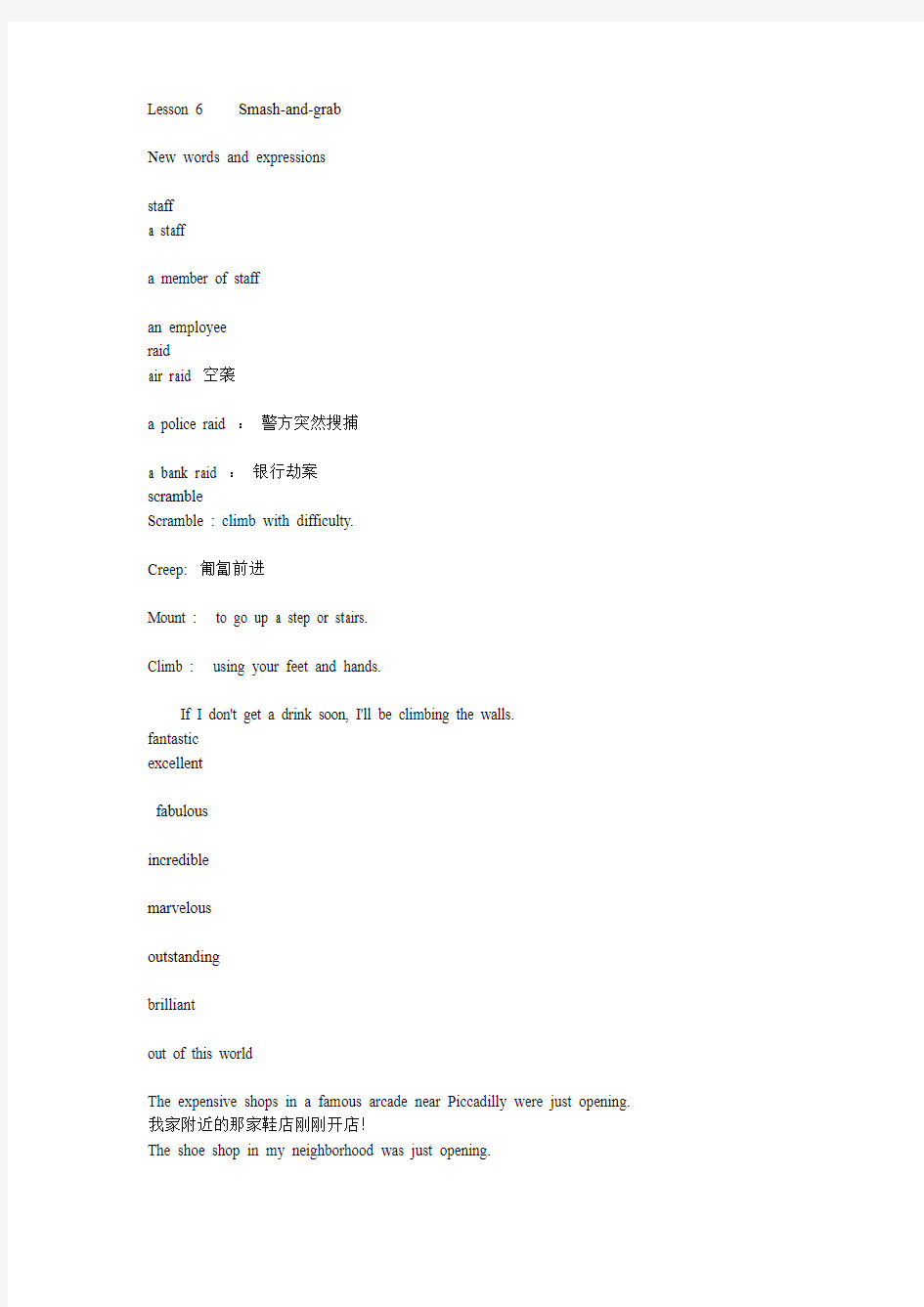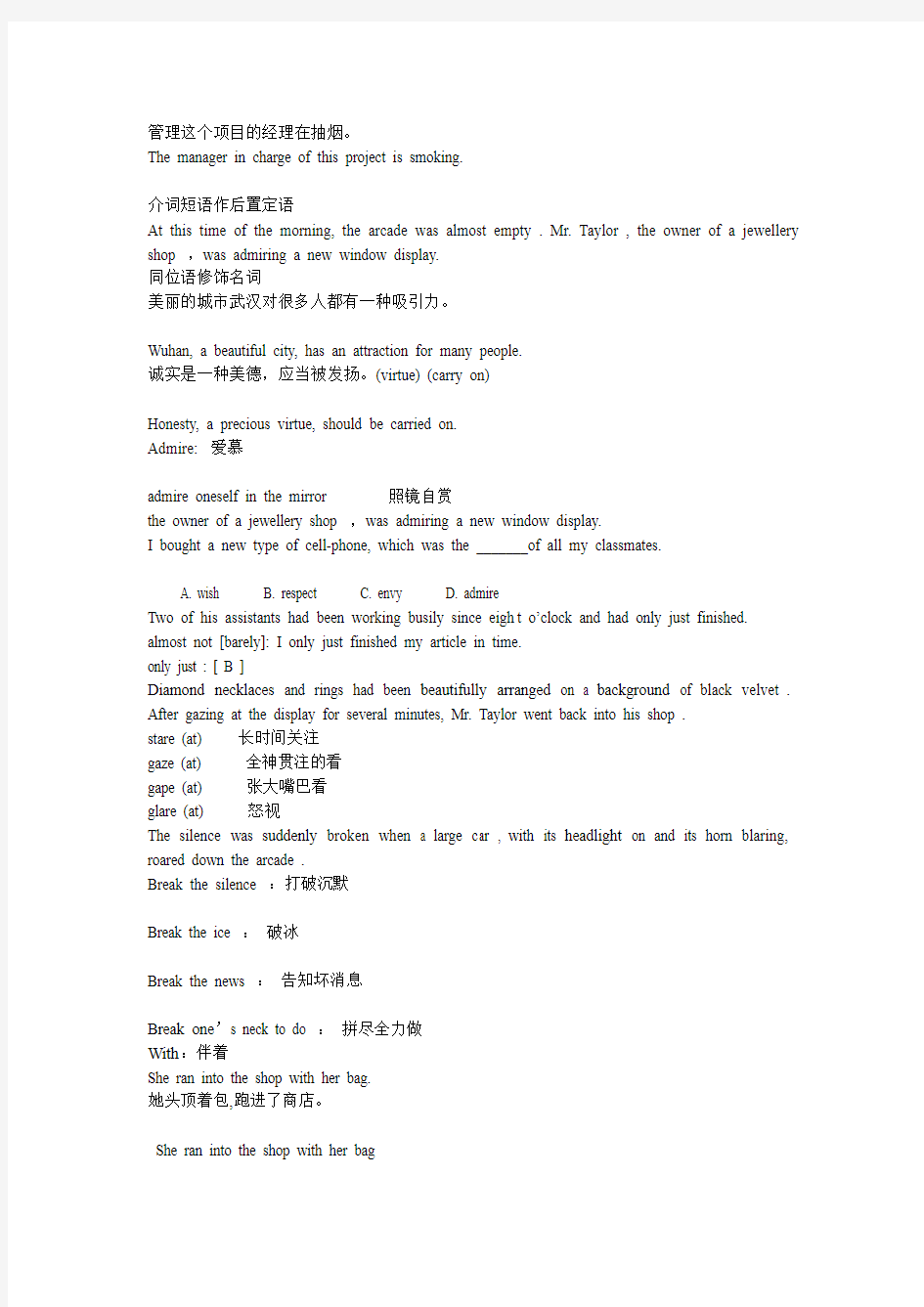Lesson 6


Lesson 6 Smash-and-grab
New words and expressions
staff
a staff
a member of staff
an employee
raid
air raid 空袭
a police raid :警方突然搜捕
a bank raid :银行劫案
scramble
Scramble : climb with difficulty.
Creep: 匍匐前进
Mount : to go up a step or stairs.
Climb : using your feet and hands.
If I don't get a drink soon, I'll be climbing the walls.
fantastic
excellent
fabulous
incredible
marvelous
outstanding
brilliant
out of this world
The expensive shops in a famous arcade near Piccadilly were just opening. 我家附近的那家鞋店刚刚开店!
The shoe shop in my neighborhood was just opening.
管理这个项目的经理在抽烟。
The manager in charge of this project is smoking.
介词短语作后置定语
At this time of the morning, the arcade was almost empty . Mr. Taylor , the owner of a jewellery shop ,was admiring a new window display.
同位语修饰名词
美丽的城市武汉对很多人都有一种吸引力。
Wuhan, a beautiful city, has an attraction for many people.
诚实是一种美德,应当被发扬。(virtue) (carry on)
Honesty, a precious virtue, should be carried on.
Admire: 爱慕
admire oneself in the mirror 照镜自赏
the owner of a jewellery shop ,was admiring a new window display.
I bought a new type of cell-phone, which was the _______of all my classmates.
A. wish
B. respect
C. envy
D. admire
Two of his assistants had been working busily since eigh t o’clock and had only just finished. almost not [barely]: I only just finished my article in time.
only just : [ B ]
Diamond necklaces and rings had been beautifully arranged on a background of black velvet . After gazing at the display for several minutes, Mr. Taylor went back into his shop .
stare (at) 长时间关注
gaze (at) 全神贯注的看
gape (at) 张大嘴巴看
glare (at) 怒视
The silence was suddenly broken when a large car , with its headlight on and its horn blaring, roared down the arcade .
Break the silence :打破沉默
Break the ice :破冰
Break the news :告知坏消息
Break one’s neck to do :拼尽全力做
With:伴着
She ran into the shop with her bag.
她头顶着包,跑进了商店。
She ran into the shop with her bag
她右手拿着包,跑进了商店。
She ran into the shop with her bag
她跑进商店,包上有层雪。
She ran into the shop with her bag
when a large car , with its headlight on and its horn blaring, roared down the arcade .
in her right arm.
on her head.
covered with snow.
With her homework finished, she felt happy.
She stood there with her hands resting on her hips.
She looked at Liuxiang with her face covered with tears.
With 描述主句中的动作,表示伴随状态
刘翔站在那里,双手举着。
Liuxiang stood there with his hands highly raised.
周立波张着大嘴指着我。
Zhoulibo , with his mouth fully open, pointed at me.
主句+ With + n. + 修饰语()
Adv.
ing
ed
Prep.
It came to a stop outside the jeweler’s. One man st ayed at the wheel while two others with black stockings over their faces jumped out and smashed the window of the shop with iron bars.
A car with its headlights missing.
two others with black stockings over their faces
= two others with black stockings covering their faces.
with跟在名词之后,可以修饰该名词。
A girl with black hair down her shoulders.
A face with an angry air on it.
A lady with big ear–rings and a mole in her right hand is smiling at me.
一位戴着大耳环,右手上有颗黑痣
的女士在冲我笑。
While this was going on , Mr. Taylor was upstairs. He and his staff began throwing furniture out of the window. Chairs and tables went flying into the arcade .
The cars flied rolling out of the forest.
汽车翻滚着飞出森林。
Tom 哭着跑出了教室。
Tom ran crying out of the classroom.
Ling ran jumping into the classroom.
玲蹦蹦跳跳跑进教室。
动词+分词,
表伴随
Went flying 飞奔进拱廊街
One of the thieves was struck by a heavy statue, but he was too busy helping himself to diamonds to notice any pain.
Too … to:
help oneself ( to sth ). 自取所需
Help yourself. 自便
Please help yourself to some cake.
be busy doing sth.
The raid was all over in three minutes ,for the men scrambled back into the car and it moved off at a fantastic speed.
at a speed of 60 mph
at top/full speed
at lightning speed
at a fantastic speed
Just as it was leaving , Mr. Taylor rushed out and ran after it throwing ashtrays and vases, but it was impossible to stop the thieves .
Throwing 分词表示伴随状态
The baker rushed out and ran after him beating with a stick.
面包师冲出来,从后面追着他,边追边拿棍打他。
Translation and practicing
The dog entered the room, following his master.
这位女孩被独自撇在屋里,哭的很凶。
The girl was left alone in the room,crying bitterly.
He glanced over at her, ______ that though she was tiny, she seemed very well put together.
A. noting
B. noted
C. to note
D. having noted
They had got away with thousands of pounds worth of diamonds .
The diamonds are worth thousands of pounds.
= It’s thousands of pounds’ worth of diamonds .
The book is worth twenty pounds .
=It’s twenty pounds‘ worth of a book .
最新科普版小学六级英语下 lesson 1-6教案学习资料
总课时:一 课题: Lesson 1 Who runs fastest in your class ? 教学内容: Let's learn 教学目 标: 1.掌握形容词、副词的比较级和最高级的用法。 2.熟练运用“Who is the tallest boy in your class ?Who runs fastest in your class ?”等交际用语,并会做替换练习。 教学重点: 目标1 教学难点: 目标1 教学易混点: 形容词、副词的比较级和最高级的用法 教学方法: 对话法 教具准备: 录音机、磁带 教学过程: (1)复习检查 教师快速出示音标卡片,让学生读。先集体读,再个别读。 (2)导入新课,出示课题
A.学习本课的12个单词及词组。 B.学习单词拼读规则:学习ir在单词中常读作 [],ar在单词中常读作[]的规则。可适当举些例子,ir在单词中常读作[],如:first、shirt、 bird、 birthday、third 、girl 、sir、 thirty、thirteen等词, ar 在单词在常读作 [],如car、 far、 farm、market、 March、park、party 、star等词,并要求学生掌握这些读音规则。 C.导入Let's learn 组织学生用对话形式导入本课的Let's learn ,主题句是“Who…?” 出示形容词、副词的比较级和最高级的用法。 a. 单音节词和少数双音节词(如以y结尾的词)词尾加–er 或–est的方式构成: 情况 构成 举例 一般情况 直接在词尾加-er或-est small-smaller-smallest 以e结尾的词 加-r或-st large-larger-largest 以“辅音+y”结尾的词 变y为i,再加-er或-est busy-busier-busiest 以一个辅音字母结尾的重读闭音节
(完整版)小学英语科普版六年级下册英语练习(Lesson6)
六年级下册英语练习题(Lesson6) 班级: 姓名: 一、将花瓣上的字母组成单词。 二、 写出下列短语的汉语意思。 1、summer holiday 2、take a trip 3、the Great Wall 4、come to an end 5、get ready for 6、Tree Planting Day 7、go on 8、cut down 9、do one ’s best 10、flow away 11、bring about 12、See you. 13、grow up 14、after some time 15、look for 16、go out 17、come to an end ___________ 18、fly back____________ 三、看图连线,图文匹配。 Canada America England France Australia Italy Russia Chin a t a e d p k e e t i r p e c h a t l b d i u k r e o r w
四、择填空。 ()1、My summer holiday is ___________. A、come B、coming C、comes ()2、Russia is __________ largest country in the world. A、the B、a C、/ ()3、We’re going to stay in Paris ___________ three days. A、at B、in C、for ()4、We _________ trees tomorrow. A、plant B、planting C、will plant ()5、We are going to _____________ the Great Wall in Beijing. A、climb B、climbing C、climbs ()6、I’ll get ready ____________ the new term. A、with B、for C、to ()7、Tree and plants can keep the water _________ flowing away. A、for B、with C、on 五、按要求完成句子。 1.Then we’ll fly to Beijing.(改为同义句) Then we will go to Beijing _________ __________ . 2.I’m going to travel around the world. (改为同义句) I’m going to___________ ____________ ____________ around the world. 3.I’ll plant trees. (对画线部分提问) 4.We will go to the park next Sunday. (改为一般疑问句) 5. I get will for the ready new term (连词成句)
典范英语1a Lesson6 教学设计 耿欣
典范英语1a Lesson6 The Pancake 教学目标: 1.知识目标:让学生了解有关做pancake所需要的用具、原材料的英文单词:pancake、the frying pan、flour、eggs、milk、butter. 2.技能目标:学生能根据课文音频,模仿其语音语调,深情的朗读并背诵这篇课文,能听 懂文中出现的单词、短语、能表演出相应的烹饪动作。 3.情感目标:学生通过这次教学活动,能够更加热爱生活、热爱家庭、热爱美食,同时树 立正确的饮食观念。 教学用具: 准备好(frying pan、flour、eggs、milk、butter、pancake)图片和单词卡,电磁炉、平底锅、盆、面粉、鸡蛋、牛奶、黄油等工具, PPT 教学设计: 1.导入: 自己戴上厨师帽装扮成厨师的样子,并给大家看pancake的图片,告诉大家今天想制作pancake,孩子通过自然发音掌握这个单词的正确读法,然后让孩子们说说制作pancake需要哪些材料。等孩子说完后,通过图片一一展示做pancake真正所需的材料(flour、eggs、milk、butter)用“What’s this?、Do you like…”的句型去问,同样通过自然发音法让孩子掌握这几个单词的发音,在教授过程中可以让孩子拍打卡片,并说出单词,加强趣味性同时对单词有着深刻的记忆。But I don’t know how to make a pancake. Let’s see how Dad and the children made a pancake. 2. 看图讲故事:理解故事情节,观察一家人一起做pancake的过程 利用课件逐幅播放故事图片,并用丰富的表情、生动的英文和适当的肢体语言给学生绘声绘色地讲故事,让学生观察一家人一起做pancake的过程并体会其乐趣,同时通过故事感受pancake race的氛围。 (Picture 1)Dad wanted to make a pancake. “This is the frying pan,” said Dad.(指向图片中的平底锅) The children wanted to help. (Picture 2)Biff put in the flour.(展示对应的图片并配合动作) Kipper put in the eggs.(展示对应的图片并配合动作) (Picture 3)Biff put in the milk.(展示对应的图片并配合动作) Chip beat it.(教师动作演示) Kipper cut the butter and put it in the frying pan.(展示对应的图片并 配合动作) (Picture 4)Dad cooked the pancake.
高级英语1 lesson 6 课文翻译及词汇
课文翻译 第6课 马克?吐温——美国的一面镜子 (节选) 诺埃尔?格罗夫 在大多数美国人的心目中,马克?吐温是位伟大作家,他描写了哈克?费恩永恒的童年时代中充满诗情画意的旅程和汤姆?索亚在漫长的夏日里自由自在历险探奇的故事。的确,这位美国最受人喜爱的作家的探索精神、爱国热情、浪漫气质及幽默笔调都达到了登峰造极的程度。但我发现还有另一个不同的马克?吐温——一个由于深受人生悲剧的打击而变得愤世嫉俗、尖酸刻薄的马克?吐温,一个为人类品质上的弱点而忧心忡忡、明显地看到前途是一片黑暗的人。 印刷工、领航员、邦联游击队员、淘金者、耽于幻想的乐天派、语言尖刻的讽刺家:马克?吐温原名塞缪尔?朗赫恩?克莱门斯,他一生之中有超过三分之一的时间浪迹美国各地,体验着美国的新生活,尔后便以作家和演说家的身分将他所感受到的这一切介绍给全世界。他的笔名取自他在蒸汽船上做工时听到的报告水深为两口寻(12英尺)——意即可以通航的信号语。他的作品中有二十几部至今仍在印行,其外文译本仍在世界各地拥有读者,由此可见他的享誉程度。 在马克?吐温青年时代,美国的地理中心是密西西比河流域,而密西西比河是这个年轻国家中部的交通大动脉。龙骨船、平底船和大木筏载运着最重要的商品。木材、玉米、烟草、小麦和皮货通过这些运载工具顺流而下,运送到河口三角洲地区,而砂糖、糖浆、棉花和威士忌酒等货物则被运送到北方。在19世纪50年代,西部领土开发高潮到来之前,辽阔的密西西比河流域占美国已开发领土的四分之三。 1857年,少年马克?吐温作为蒸汽船上的一名小领航员踏人了这片天地。在这个新的工作岗位上,他接触到的是各式各样的人物,看到的是一个多姿多彩的大干世界。他完全地投身到这种生活之中,经常在操舵室里听着人们谈论民间争斗、海盗抢劫、私刑案件、游医卖药以及河边的一些化外民居的故事。所有这一切,连同他那像留声机般准确可靠的记忆所吸收的丰富多彩的语言,后来都有机会在他的作品中得以再现。 蒸汽船的甲板上不仅挤满了富有开拓精神的人们,而且也载着一些娼妓、赌棍和歹徒等社会渣滓。从所有这些形形色色的人身上,马克?吐温敏锐地认识了人类,认识了人们的言与行之间的差距。他在蒸汽船上工作的四年半时间是他真正接受教育的开端,而且也是最具有深远意义的教育。到了晚年,马克?吐温还声言是密西西比河使他了解了各种各样的人的本性。这种生活体验对他的全部创作都起了促进作用,然而他描写得最为成功的还是那些密西西比河上的人物。
Lesson6教案北京教育英语
课题:Lesson6 第6课时授课时间:40min 教学目标 1.能听懂、会说“What do you do in the afternoon?”及其答语,能在实际情景中运用。 2.能听、说、读、写Hh,体会其在单词中的读音/h/ 3. 能听懂、会说、整体认读a flag, a fox, a gift及grapes 4.能背诵、表演小韵文H for head, 能听懂并很具指令做游戏,开展活动。 习惯培养目标:培养学生善于与人交流的能力。 学困生要求:能够听懂会说本课的功能句式,指读所学单词,根据范例仿写字母。 教学重难点 重点:能用本课功能句式进行对话,能够正确认读字母、单词。 难点:能正确书写字母Hh。 教学过程 一、Greetings T: Hello, boys and girls. Glad to see you again. Are you happy? 二、Presentation and practice 活动一:看一看,说一说 1.教师请学生边看主题图,边观察图,边说出认识的人物,如:Lingling等 2.教师加大输入信息量,如:Play games have PE 、play games 3.请学生随意指出图中认识的物体,并可作简单描述 T: Boys and girls , let’s look at the picture. Who are in the picture?where are they? In the classroom? They are on the playground.What class do they have? English class? OK! PE. They have PE. Do you like PE class? What do you do in PE class? Do you play games? There are so many things in the picture, what can you see in the picture? 活动二:学习课文对话 1.教师在黑板上出示本课课文,并引导学生用学过的音图拼出课文中的生单词:afternoon, play games等 2.请个别学生拼读该单词后,让学生集体拼读单词,扫除课文认读的障碍 3.指导学生在书上标出对话中认读有困难的单词 Lala: What do you do in the afternoon, Lingling?
新概念英语第2册课程讲义Lesson6
Lesson6单词讲解 1.beggar n.乞丐 beg v.乞讨;乞求,恳求 beg for food beg for help I beg your pardon?=Pardon? 2.pocket n.衣服口袋 pocket money 3.call v.拜访,光顾 call on sb./call at sp. He calls on his grandfather every week. The train called at Oxford just now. visit sb./sp. Lesson6课文&语法讲解 冠词的作用定冠词the 不定冠词a/an 零冠词 Lesson8课文&语法讲解 冠词的作用 定冠词the表示特制不定冠 词a/an表示泛指零冠词 不加冠词表示特殊用途 泛指特指 不明确的对象明确的对象 I am hungry.I want the apple in your I want an apple.hand. 首次提到的对象再次提到的对象 I saw a dog in Bridge Street yesterday.The dog was really cute.
______air pollution is a serious problem. ______air pollution of Beijing must be solved at once. Lisa gave me______tea as______gift. ______tea tasted good. Last month I bought______CD.______CD is about the Civil War,and I found ______CD very interesting. I enjoy reading.Although______books are expensive,I always buy______ books in______bookstore in London Street. 1.I have just moved to______house in Bridge Street. 2.Yesterday______beggar knocked at my door. 3.He asked me for______meal and______glass of beer. 4.In return for this,______beggar stood on his head and sang songs. 5.I gave him a meal. 6.He ate______food and drank______beer. 7.Then he put______piece of cheese in his pocket and went away. https://www.360docs.net/doc/f46915044.html,ter______neighbour told me about him. 9.Everybody knows him. 10.His name is Percy Buttons. 11.He calls at every house in______street once a month and always asks for a meal and a glass of beer. Lesson6知识拓展 本课重点: 冠词 a/an/the 冠词 As everyone knows,_______children require a lot of time and attention. A:Frank,where are_______children? B:Next door at the Jacksons’. 冠词 ______water is essential to human life, but don’t drink______water in the Flat River. It’ll kill you!________pollution in that river is terrible.
六年级下册英语素材- Lesson 5---Lesson 6 讲义(带习题) 人教精通版
Lesson 5 1.Good morning, every one! I’m Li Yan. Let me tell you how we learned English. 大家早上好! 我是李燕。让我告诉你们我们是怎样学习英语的。 everyone 不定代词,意为“大家,每个人”。注意:everyone 后面的谓语动词应为单数。let+宾语(宾格)+动词原形 tell sb+ how 从句,告诉某人如何…… how 从句里可以有自己的主语、谓语。learn 动词,意为“学习;学会”指从研究、经验或他人的传授中获得知识和技能,侧重学习的结果。 例:He learn English well. 他英语学得很好。learn(近义词) → study “学习,研究”。(1)Let me to tell you how we________ (learn) English. (2)Let me_______(tell) you some interesting stories. (3)_______(be) everyone at school yesterday ? 2.Three years ago we began to learn English. Our English teacher taught us in many ways, so we were very interested in English lessons. 三年前我们开始学习英语。我们的英语老师用很多方法教我们,因此我们对英语课非常感兴趣。 teach 是动词,意为“讲授;教授”。 teach(过去式)→taught (1)作不及物动词 例:She teaches at our school. 她在我们学校任教。 (2)作及物动词,常构成以下结构: ① teach+(双)宾语 例:He teaches (us) French. 他教(我们)法语。 ① teach+宾语+动词不定式。 例:She taught her son to draw. 她教她的儿子画画。 ① teach+宾语+that从句 例:My parents taught me that honesty was always the best policy. 我父母教导我,诚 实永远是最佳原则。 in many ways 用很多方法 (1)Two years ago, she _____ to learn to sing. A. begin B. began C. begins D. beginning (2)We were______in English lessons. A. interesting by B. very interesting C. interested very D. very interested (3)Our English teacher taught_______(we) in many ways. (4)Our English teacher taught us_______ many ways. (5)We were very interested in English lessons. (同义句) We______English lessons______ ______. (6)We were very interested in English lessons. (改为否定句) We______ ______ interested in English
